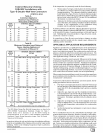
Z223.1-2002/NFPA54-2002;and/orSection7andAppendixCof
theCSAB149.1-05,NationalStandardofCanada,NaturalGas
andPropaneInstallationCode;thelocalbuildingcodes;furnace
andventmanufacturer'sinstructions.
NOTE: The following instructions comply with the ANSI
Z223.1/NFPA 54 National Fuel Gas Code and CSA B149.1 Natu-
ral Gas and Propane Installation code, based on the input rate on
the furnace rating plate.
1,
If a Category ] vent passes through an attic, any concealed
space or floor, use ONLY Type B or Type L double wall vent
pipe. If vent pipe passes through interior wall, use Type Bvent
pipe with ventilated thimble ONLY.
2. Do NOT vent furnace into any chimney serving an open fire-
place or solid fuel burning appliance.
3. Use the same diameter Category ] connector or pipe as per-
mitted by:
the National Fuel Gas Code Code (NFGC) ANSI
Z223.1-2002 / NFPA 54-2002 sections 10 and 13 vent-
ing requirements in the United States
or
the National Standard of Canada Natural Gas and Pro-
pane Installation Code (NSCNGPIC) CSA B149.1-05
section 7 and appendix C venting requirements in Cana-
da.
4, Push the vent connector onto the furnace flue collar of the
venter assembly until it touches the bead (at least 5/8" overlap)
and fasten with at least two field-supplied, corrosion-resist-
ant, sheet metal screws located at least 140 ° apart.
5. Keep vertical Category [ vent pipe or vent connector runs as
short and direct as possible.
6. Vertical outdoor runs of Type-B or ANY single wall vent pipe
below the roof line are NOT permitted.
7. Slopeallhorizontalrunsupfromfurnacetotheventterminal a
minimum of 1/4" per foot (21 mm/m).
8. Rigidly support all horizontal portions of theventing system ev-
ery 6' or less using proper clamps and metal straps to prevent
sagging and ensure there is no movement after installation.
9. Check existing gas vent or chimney to ensure they meet clear-
ances and local codes. See Figure 1
10. The furnace MUST be connected to a factory built chimney or
vent complying with a recognized standard, or a masonry or
concrete chimney lined with a lining material acceptable to the
authority having jurisdiction. Venting into an unlined ma-
sonry chimney or concrete chimney is prohibited. See the
6. Masonry Chimney Venting section in these instruc-
tions.
11. Fan-assisted combustion system Category ] furnaces shall
not be vented into single-wall metal vents.
12. Category ] furnaces must be vented vertically or nearly verti-
cally, unless equipped with a listed mechanical venter.
13. Vent connectors serving Category I furnaces shall not be con-
nected into any portion of mechanical draft systems operating
under positive pressure.
Venting and Combustion Air Check
CARBON MONOXIDE POISONING HAZARD
Failure to follow the steps outlined below for each
appliance connected to the venting system being placed
into operation, could result in carbon monoxide
poisoning or death:
The following steps shall be followed for each appliance
connected to the venting system being placed into
operation, while all other appliances connected to the
venting system are not in operation:
1.Seal any unused openings in the venting system.
2.Inspect the venting system for proper size and horizontal
pitch, as required in the National Fuel Gas Code, ANSI
Z223,1/NFPA 54 or CSA B149.1, Natural Gas and
Propane Installation Code and these instructions. Deter-
mine that there is no blockage or restriction, leakage, cor-
rosion and other deficiencies which could cause an unsafe
condition.
3.As far as practical, close all building doors and windows
and all doors between the space in which the appliance(s)
connected to the venting system are located and other
spaces of the building.
4.Close fireplace dampers.
5.Turn on clothes dryers and any appliance not connected to
the venting system. Turn on any exhaust fans, such as
range hoods and bathroom exhausts, so they are
operating at maximum speed. Do not operate a summer
exhaust fan.
6. Follow the lighting instructions. Place the appliance being
inspected into operation. Adjust the thermostat so
appliance is operating continuously.
7.Test for spillage from draft hood equipped appliances at
the draft hood relief opening after 5 minutes of main burner
operation. Use the flame of a match or candle. (Figure 9)
8.If improper venting is observed, during any of the above
tests, the venting system must be corrected in accordance
with the National Fuel Gas Code, ANSI Z223,1/NFPA 54
and/or CSA B149, 1, Natural Gas and Propane Installation
Code.
9.After it has been determined that each appliance con-
nected to the venting system properly vents when tested
as outlined above, return doors, windows, exhaust fans,
fireplace dampers and any other gas-fired burning
appliance to their previous conditions of use.
Vent Check
Vent Pipe _1 I A/ Draft Hood
Typical Gas
Water Heater
!
II d dft hoJd
NOTE: If fame pu s towar s ra , this indicates
sufficient infiltration air.
NOTE: When an existing Category I furnace is removed or re-
placed, the original venting system may no longer be sized to prop-
erly vent the attached appliances, and to make sure there is
adequate combustion air for all appliances, MAKE THE FOL-
LOWING CHECK.
/2N
Venting to Existing Masonry Chimney
Dedicated venting of one fan assisted furnace into any ma-
sonry chimney is restricted. A chimney must first be lined with
either Type B vent sized in accordance with NFGC tables 13.1 or
441 01 261302


















